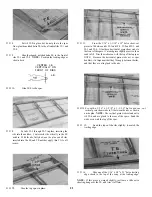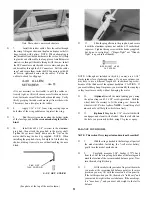
COMPLETION
MAKE THE ELEVATOR PUSHROD
D 1. You'll need the following: 1/4" x 1/4" x 17-1/4"
balsa stick, 12" pushrod wire (threaded one end), nylon
clevis, and strong thread (not included).
NYLON CLEVIS
D 2. Clean the pushrod wire with alcohol or solvent to
remove all oils from the surface.
D 5. Drill 5/64" holes through the stick at the end of the
grooves you made in the above step.
D 6. Screw a nylon clevis on the threaded end of the
steel pushrod wire. Screw it all the way on, until the wire is
visible inside the clevis (about 17 full turns). Note: The
wire will be easier to hold if you grasp it with a pliers.
D 3. Draw a line 1 -inch long on both ends of the 1/4" x
1/4" x 17-1/4" balsa stick to mark the locations of the
pushrod wire grooves.
D 7. Lay the wire on the fuse plan (side view), and
notice where the wire makes a 90-degree bend and goes into
the stick and mark that location on the wire. Make this bend
now and cut off the excess wire.
D 4. Use the threaded end of one of the wire pushrods
to "file" grooves in the balsa stick where you drew the lines.
The depth of the grooves should be about 1/2 the thickness
of the wire.
D 8. Take the straight wire that you cut off and make a
short 90-degree bend in the end. Also notice the slight bend
near the midpoint of the wire (see plan).
D 9. Use sandpaper to roughen the ends of the wires
that will be glued into the balsa slicks.
27














































